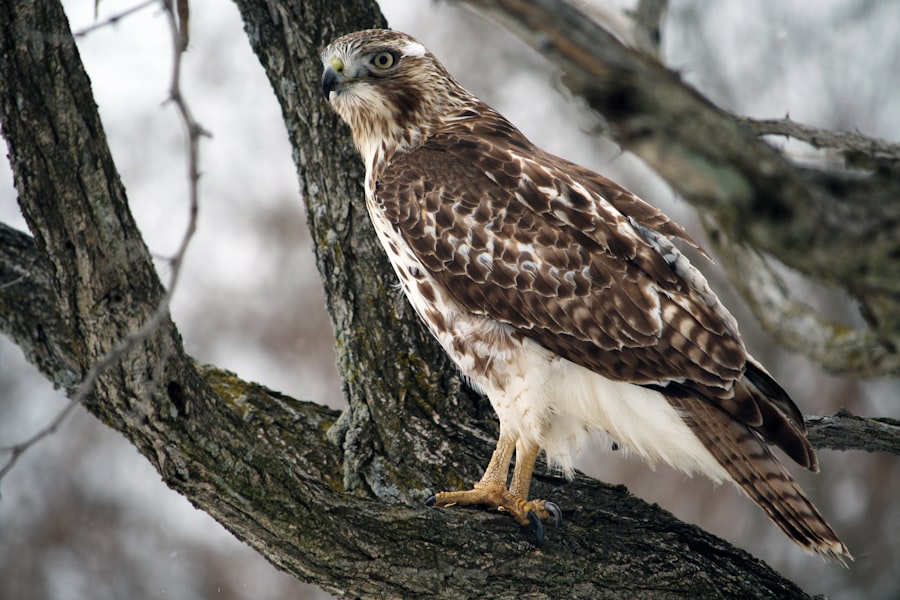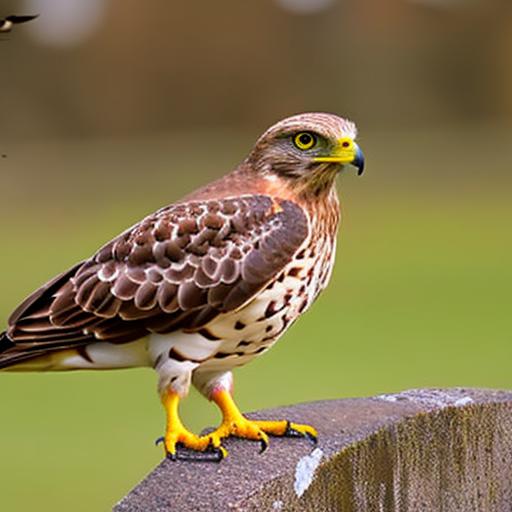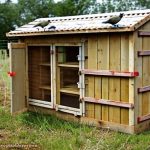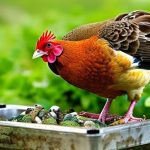Hawks are a common predator that pose a significant threat to backyard chickens. These majestic birds of prey can swoop down and snatch a chicken in a matter of seconds, leaving owners devastated and their flocks vulnerable. Protecting your flock from hawks is crucial to ensure their safety and well-being. In this article, we will explore the different ways hawks pose a danger to chickens, identify common hawk species in North America, and provide tips and tricks for creating a safe and secure chicken coop.
Key Takeaways
- Hawks pose a serious threat to your chickens and can cause significant harm.
- Identifying common hawk species in your area can help you better understand the threat.
- Creating a safe and secure chicken coop is essential to protecting your flock.
- Installing fencing and netting can help keep hawks out of your chicken coop.
- Providing adequate shelter and hiding places for your chickens can help keep them safe from hawks.
Understanding the Threat: Why Hawks Pose a Danger to Your Chickens
Hawks are natural predators that have evolved to hunt and feed on small animals, including chickens. They have sharp talons and powerful beaks that allow them to capture and kill their prey quickly. Hawks are known for their exceptional eyesight, which enables them to spot potential targets from great distances. Once they have identified a chicken as their prey, they will swoop down with incredible speed and accuracy.
There are several ways in which hawks attack chickens. The most common method is the aerial attack, where the hawk will dive from above and grab the chicken with its talons. This attack is swift and often fatal for the chicken. Hawks can also attack chickens on the ground, using their sharp beaks to deliver a lethal blow. Additionally, hawks may target chicks or smaller chickens that are more vulnerable due to their size.
Identifying Common Hawk Species in Your Area
In North America, there are several common hawk species that backyard chicken owners should be aware of. These include the Red-tailed Hawk, Cooper’s Hawk, Sharp-shinned Hawk, and Northern Goshawk.
The Red-tailed Hawk is one of the most widespread hawk species in North America. It has a distinctive reddish-brown tail and can be found in a variety of habitats, including forests, fields, and suburban areas.
Cooper’s Hawks are medium-sized hawks with a slate-gray back and a reddish-brown barred chest. They are known for their agility and speed, making them formidable hunters.
Sharp-shinned Hawks are small hawks with short wings and long tails. They have a bluish-gray back and pale underparts with fine horizontal barring. These hawks are known for their quick and agile flight, which allows them to navigate through dense vegetation in pursuit of their prey.
Northern Goshawks are large hawks with a dark gray back and a white underbelly. They have a distinctive white eyebrow stripe and red eyes. These hawks are found primarily in forested areas and are known for their powerful flight and hunting abilities.
Creating a Safe and Secure Chicken Coop: Tips and Tricks
| Topic | Metric |
|---|---|
| Coop Size | Minimum of 4 square feet per chicken |
| Roosting Bars | 1.5 inches wide and 2-3 feet off the ground |
| Nesting Boxes | 1 box per 3-4 chickens, 12x12x12 inches in size |
| Wire Mesh | 1/2 inch hardware cloth to prevent predators |
| Run Area | Minimum of 10 square feet per chicken |
| Food and Water | Provide fresh water and food daily, and secure containers to prevent contamination and spillage |
| Cleaning | Clean coop and run area weekly to prevent disease and pests |
One of the most important steps in protecting your flock from hawks is to create a safe and secure chicken coop. A secure coop will not only keep hawks out but also protect your chickens from other predators such as raccoons, foxes, and snakes.
When building a chicken coop, it is essential to use sturdy materials that cannot be easily broken or penetrated by hawks. Reinforce the walls, roof, and floor of the coop to ensure that there are no weak points where a hawk could gain entry. Use hardware cloth or welded wire mesh with small openings to cover windows and vents, as this will prevent hawks from reaching through and grabbing chickens.
It is also important to consider the height of the coop. Hawks can swoop down from above, so make sure the coop is tall enough to deter them from attempting an attack. Additionally, consider adding a roof or netting over the chicken run to provide extra protection.
Installing Fencing and Netting to Keep Hawks Out
In addition to securing the chicken coop, installing fencing and netting can be an effective way to keep hawks out of your chicken area. Fencing should be at least six feet tall and buried at least a foot into the ground to prevent hawks from digging under it. Use sturdy materials such as welded wire or chain-link fencing to ensure that hawks cannot break through.
Netting can also be used to create a physical barrier between hawks and your chickens. Install netting over the chicken run, making sure it is securely fastened to prevent hawks from getting tangled or breaking through. Choose netting with small openings to prevent hawks from reaching through and grabbing chickens.
When installing fencing and netting, it is important to regularly inspect and maintain them to ensure they remain secure. Repair any holes or weak spots immediately to prevent hawks from exploiting them.
Providing Adequate Shelter and Hiding Places for Your Chickens

In addition to a secure coop and fencing, providing adequate shelter and hiding places for your chickens can help protect them from hawks. Chickens instinctively seek cover when they sense danger, so having hiding places in their outdoor area can give them a safe space to retreat to.
Provide dense vegetation or shrubs in the chicken area where chickens can hide from hawks. Planting trees or installing large shrubs can provide natural cover and make it more difficult for hawks to spot your chickens from above.
It is also important to provide adequate shelter within the chicken coop itself. Have multiple roosting bars at different heights so that chickens can choose where they feel safest. Provide nesting boxes that are enclosed on all sides, as this will give chickens a secure place to lay their eggs without fear of hawk attacks.
The Importance of Supervision and Vigilance in Protecting Your Flock
Supervision and vigilance are crucial in protecting your flock from hawk attacks. Hawks are opportunistic predators and will take advantage of any opportunity to snatch a chicken. By keeping a close eye on your chickens, you can intervene quickly if a hawk is spotted.
Make it a habit to regularly check on your chickens throughout the day, especially during times when hawks are most active, such as early morning and late afternoon. If you see a hawk circling overhead or perched nearby, take immediate action to scare it away.
Using Deterrents and Scare Tactics to Keep Hawks Away
There are several deterrents and scare tactics that can be used to keep hawks away from your chickens. One effective method is to use visual deterrents such as scarecrows, reflective tape, or shiny objects. Hang these items near the chicken coop or in the chicken run to create movement and reflection that will deter hawks.
Another effective scare tactic is to use noise deterrents. Install motion-activated devices that emit loud noises when a hawk is detected. This will startle the hawk and discourage it from approaching your chickens.
Implementing Natural Predation Control Methods
Implementing natural predation control methods can also help protect your flock from hawks. One effective method is to introduce a rooster into your flock. Roosters are natural protectors and will sound the alarm if they sense danger. They will also defend the hens against predators, including hawks.
Another natural predation control method is to provide hiding places for smaller chickens or chicks. Hawks are more likely to target smaller chickens that are easier to capture. By providing hiding places such as dense vegetation or small shelters, you can give smaller chickens a safe space to retreat to.
Educating Your Neighbors and Community about Hawk Safety
Educating your neighbors and community about hawk safety is essential in protecting your flock. Many people may not be aware of the threat that hawks pose to backyard chickens and may inadvertently attract them by leaving out food or providing perching spots.
Take the time to educate your neighbors about the importance of securing their chickens and not leaving out food that could attract hawks. Encourage them to implement the same protective measures that you have taken to ensure the safety of their flocks.
Seeking Professional Help: When to Call in a Wildlife Expert
In some cases, it may be necessary to call in a wildlife expert for assistance in dealing with hawk attacks. If you have tried various deterrents and protective measures but continue to experience hawk attacks, it may be time to seek professional help.
A wildlife expert can assess your situation and provide recommendations tailored to your specific needs. They may suggest additional deterrents or modifications to your coop and chicken area that will make it more secure against hawk attacks.
When seeking a wildlife expert, it is important to choose a reputable professional with experience in dealing with hawk-related issues. Ask for recommendations from local poultry associations or other chicken owners in your area.
Protecting your flock from hawks is crucial to ensure their safety and well-being. By understanding the threat that hawks pose, identifying common hawk species in your area, and implementing protective measures such as creating a secure coop, installing fencing and netting, providing shelter and hiding places, and being vigilant, you can greatly reduce the risk of hawk attacks on your chickens. Educating your neighbors and community about hawk safety and seeking professional help when necessary are also important steps in protecting your flock. By taking action to protect your chickens from hawks, you can provide them with a safe and secure environment to thrive in.
If you’re looking for ways to protect your chickens from hawks, you might also be interested in learning about how to care for goslings. Geese can be vulnerable to predators like hawks, so it’s important to take precautions to keep them safe. Poultry Wizard has a helpful article on how to care for goslings that provides valuable tips and advice on raising these adorable birds. By implementing some of the strategies mentioned in this article, you can not only protect your goslings but also create a safer environment for your chickens.
FAQs
What is a hawk?
A hawk is a bird of prey that belongs to the family Accipitridae. They are known for their sharp talons and beaks, and are skilled hunters.
Why do hawks attack chickens?
Hawks attack chickens because they are a source of food. Chickens are easy prey for hawks because they are slow-moving and cannot fly very high.
How can I tell if a hawk is attacking my chickens?
If you see a hawk circling above your chicken coop or if you notice missing or injured chickens, it is likely that a hawk is attacking your chickens.
What are some ways to keep hawks away from chickens?
Some ways to keep hawks away from chickens include using scare tactics such as reflective tape or fake owls, providing cover for chickens to hide under, and keeping chickens in a covered area.
Is it legal to kill hawks that are attacking my chickens?
No, it is illegal to kill hawks as they are protected under the Migratory Bird Treaty Act. Instead, it is recommended to use non-lethal methods to deter hawks from attacking your chickens.
Meet Walter, the feathered-friend fanatic of Florida! Nestled in the sunshine state, Walter struts through life with his feathered companions, clucking his way to happiness. With a coop that’s fancier than a five-star hotel, he’s the Don Juan of the chicken world. When he’s not teaching his hens to do the cha-cha, you’ll find him in a heated debate with his prized rooster, Sir Clucks-a-Lot. Walter’s poultry passion is no yolk; he’s the sunny-side-up guy you never knew you needed in your flock of friends!







